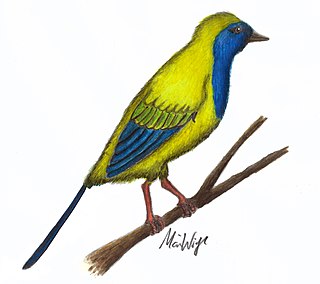
Kurixalus is a genus of frogs in the family Rhacophoridae. The taxonomy of small rhacophids is difficult and has been subject to many revisions, but molecular genetic data do support monophyly of Kurixalus. These frogs are distributed from Himalayan front ranges of eastern India southward and eastward to Cambodia, Vietnam, southern China, Taiwan, and the Ryukyu Islands.

Eosipterus is an extinct genus of pterosaur from the Early Cretaceous of Liaoning, China.

Tylototriton is a genus of newts known as crocodile newts or knobby newts. About 25 known species are in this genus. Many species have been described just recently. They range from northeastern India and Nepal through Burma to northern Thailand, Laos, Vietnam, and southern China.
The black knobby newt is a species of salamanders in the family Salamandridae found in China and Vietnam. Its natural habitats are subtropical or tropical moist lowland forests, subtropical or tropical moist montane forests, freshwater marshes, and intermittent freshwater marshes. It is threatened by habitat loss and overharvesting.
The red-tailed knobby newt or Kweichow (crocodile) newt is a species of salamander in the family Salamandridae. It is found in western Guizhou and north-eastern Yunnan, China. It is most closely related to emperor newt and Himalayan newt.

Liaoxiornis is a dubious genus of enantiornithine bird. The only named species is Liaoxiornis delicatus, described by Hou and Chen in 1999. Because the species was named for a hatchling specimen, it cannot be matched with adult specimens, and so it is impossible to determine which, if any, birds from the same rocks represent adults of this species. Luis Chiappe and colleagues therefore regarded it as a nomen vanum or at least a nomen dubium, and recommended that use of the name be abandoned.

Three Kingdoms is a 2010 Chinese television series based on the events in the late Eastern Han dynasty and the Three Kingdoms period. The plot is adapted from the 14th century historical novel Romance of the Three Kingdoms and other stories about the Three Kingdoms period. Directed by Gao Xixi, the series had a budget of over 160 million RMB and took five years of pre-production work. Shooting of the series commenced in October 2008, and it was released in China in May 2010.
Jibeinia is a genus of enantiornithean bird. Only one species has been named, Jibeinia luanhera. It is known from one holotype fossil found in the Hebei province, People's Republic of China. This fossil is now lost. The holotype was, however, described and figured in detail by Hou (1997).

Royal Tramp is a 2008 Chinese television series adapted from Louis Cha's novel The Deer and the Cauldron. Produced by Zhang Jizhong and Huayi Brothers, the series consists of 50 episodes, filmed in high definition. The series was first broadcast on Jiangsu TV in China in 2008 and was subsequently aired on TVB in Hong Kong and other countries.
Li Tien-lu was a Taiwanese puppeteer. He is best known to the international audience for playing principal characters in several Taiwanese films directed by Hou Hsiao-hsien.
Zhongjianornis is a genus of beaked, pigeon-sized birds from the early Cretaceous period of China. It is known from one fossil found at Jianchang, Liaoning Province, in rocks of the Jiufotang Formation, representing the type species Zhongjianornis yangi.

The Legend of the Condor Heroes, also released as Legend of Eagle Shooting Hero and Legend of the Arching Hero, is a Chinese television series adapted from Louis Cha's novel The Legend of the Condor Heroes. It is the first instalment of a trilogy produced by Zhang Jizhong, followed by The Return of the Condor Heroes (2006) and The Heaven Sword and Dragon Saber (2009). It was first broadcast on CCTV in China in 2003.

The Heaven Sword and Dragon Saber is a Chinese television series adapted from Louis Cha's novel of the same title. It is a final instalment of a television trilogy produced by Zhang Jizhong, preceded by The Legend of the Condor Heroes (2003) and The Return of the Condor Heroes (2006). Unlike the previous adaptations, this remake is the first to be primarily based on the third edition of the novel. The series was first broadcast on Wenzhou TV in China in October 2009.

The Taiping Heavenly Kingdom is a Chinese television series based on the events of the Taiping Rebellion and the rise and fall of the Taiping Heavenly Kingdom in the late Qing dynasty. The 48-episode series was first broadcast on CCTV in China in 2000. The series was also broadcast on STAR Chinese Channel in Taiwan and on ATV in Hong Kong.
Camptodontornis is an extinct genus of enantiornithine bird which existed in what is now Chaoyang in Liaoning Province, China during the early Cretaceous period. It is known from a well-preserved skeleton including a skull found in the Jiufotang Formation of Liaoning Province. Its original generic name was "Camptodontus" ; it was named by Li Li, En-pu Gong, Li-dong Zhang, Ya-jun Yang and Lian-hai Hou in 2010. However, the name had previously been used for a genus of beetle. The type species is "Camptodontus" yangi. Demirjian (2019) coined a replacement generic name Camptodontornis. The status of C. yangi as a distinct species is disputed, with Wang et al. (2015) considering it to be a probable synonym of Longipteryx chaoyangensis.
Gracilornis is an extinct genus of early bird from the lower Cretaceous. It is a cathayornithid enantiornithine which lived in what is now western Liaoning Province, China. It is known from a nearly complete skull and postcranial skeleton, which was found from the Jiufotang Formation, in Chaoyang. It was first named by Li Li and Hou Shilin in 2011 and the type species is Gracilornis jiufotangensis. The generic name is derived from Latin gracilis, "slender" and Greek ornis, "bird", and refers to its slender skeleton. The specific name was named after the Jiufotang Formation, in which the holotype was collected.

The Legend of the Condor Heroes is a 2017 Chinese television series adapted from Louis Cha's novel of the same title and a remake of the 1983 Hong Kong television series based on the same novel. The series was directed by Jeffrey Chiang and starred Yang Xuwen, Li Yitong, Chen Xingxu and Meng Ziyi in the lead roles. It started airing on Dragon TV in mainland China on 9 January 2017, and on TVB Jade in Hong Kong on 8 May 2017.












